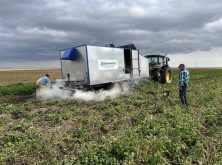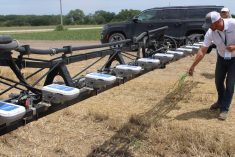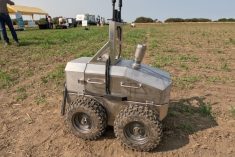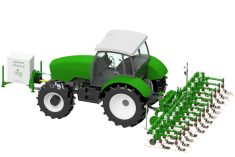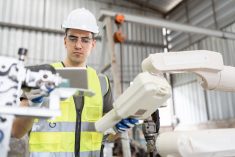Weeds can take over farm fields and lead to significant crop losses. Without adequate control, crop yields could decline up to 50 per cent in corn and soybean fields across the United States and Canada, resulting in US$43 billion in economic losses, according to data from the Weed Science Society of America. Additionally, controlling weeds takes significant amounts of time and capital.
Enter robotic weeders. These autonomous machines address many issues from herbicide resistance to labour shortages. Companies ranging from John Deere and FarmWise Labs in San Francisco to the French agricultural robotics company, Naio Technologies, have all developed autonomous weeding equipment. Although the technology is still in its infancy, successful field tests give farmers hope for the future.
Read Also

Claas brings 1000 Series SP forage harvesters to Canada
In mid-August, Claas unveiled its new line of Jaguar forage harvesters at an event in Visalia, California, deep in the heart of that state’s dairy region.
Halifax-based Nexus Robotics started working on its autonomous weeding robot, R2-Weed2, in 2017. The machine uses artificial intelligence to distinguish between weeds and crops and, once weeds are identified, R2-Weed2 either applies a dose of herbicide or pulls the weeds from the roots.
“Most farmers are desperate to find a solution to their problems with weeds,” says Teric Greenan, CEO of Nexus Robotics.
Compared to farm workers who can weed up to one-third of an acre per day, the robot can weed up to five acres per day (assuming 24 hours of operation). During trials on a Nova Scotia farm, the robotic weeder removed or killed 90 per cent of weeds during the growing season and additional field trials will take place in Quebec this summer. Greenan anticipates a commercial release in 2021.
Cultivating worldwide demand
Autonomous weeding machines are already pulling weeds on farms outside of Canada. International companies like Robovator, Garford and Steketee IC have commercialized their technologies and their weeders (distributed in the United States through dealers like Quinn Tractor, Sutton Ag and Pacific Ag Rentals) are removing weeds from the seedlines on vegetable farms.
In Salinas, Calif., Pacific Ag Rentals is the first U.S. dealer to offer the Robovator, a robotic hoeing machine that uses sharp knives to grab and pull weeds among row crops. The machine works on high-value vegetable crops such as lettuce, cauliflower and broccoli, and is 90 per cent accurate in removing weeds from transplanted crops.

Walker, noting that one machine can replace up to 10 farm workers, hoped to sell the machines to farmers who struggled to find labourers and needed an efficient and effective method of killing weeds. Sales of the units, which cost up to US$160,000, were slower than anticipated so the California company transitioned to offering the technology as a service: Pacific Ag Rentals provides the tractor, weeder and a driver to handle weeding.
Nexus Robotics plans to take a similar approach with R2-Weed2, charging a per acre fee for the weeding service and later selling the units.
“It’s autonomous but it still needs to be supervised to some extent and operating it is not trivial,” Greenan says. “Things can go wrong and we don’t want that responsibility on the farmers until the technology is more reliable.”
While the first robotic weeding machines are just starting to be deployed on farms, companies are already working on next-generation technologies that use GPS guidance, machine learning, robotics and solar power to rid farm fields of weeds.
“There are multiple robotic weeders out there right now and lots of different technologies but they all do the same thing,” says Bart Walker, president of Pacific Ag Rentals. “Are there advances we could use to get them to be better weeders? Yes. But it’s exciting to see how technology in agriculture can make us a lot more efficient.”

As the technology for autonomous weeders grows, Greenan believes that they will become as common on farms as tractors, sprayers and air carts.
“Over the next five to 10 years, [robotic weeders] will go from precommercial to standard,” Greenan says. “The technology will become much more efficient and the cost will keep going down — and the cost of labour will keep going up — and that’s going to make them much more than just a fringe thing.”




